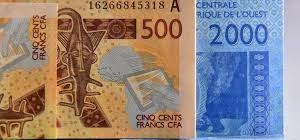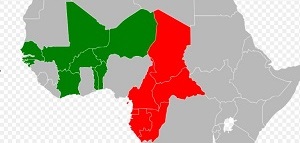CFA franc


The CFA franc (in French: franc CFA [fʁɑ̃ seɛfɑ], Franc of the Financial Community of Africa, originally Franc of the French Colonies in Africa, or colloquially franc) is the name of two currencies, the West African CFA franc, used in eight West African countries, and the Central African CFA franc, used in six Central African countries. Both currencies are guaranteed by the French treasury. Although separate, the two CFA franc currencies have always been at parity and are effectively interchangeable. The ISO currency codes are XAF for the Central African CFA franc and XOF for the West African CFA franc. On 22 December 2019, it was announced that the West African currency would be replaced by an independent currency to be called Eco.
Both CFA francs have a fixed exchange rate to the euro: 100 CFA francs = 1 former French (nouveau) franc = 0.152449 euro; or 1 € = 6.55957 FRF = 655.957 CFA francs exactly.
CFA franc Usage
CFA francs are used in fourteen countries: twelve nations formerly ruled by France in West and Central Africa (excluding Guinea and Mauritania, which withdrew), plus Guinea-Bissau (a former Portuguese colony), and Equatorial Guinea (a former Spanish colony). These fourteen countries have a combined population of 147.5 million people (as of 2013), and a combined GDP of US$166.6 billion (as of 2012). The ISO currency codes are XAF for the Central African CFA franc and XOF for the West African CFA franc.
CFA franc Evaluation
The currency has been criticized for making economic planning for the developing countries of French West Africa all but impossible since the CFA's value is pegged to the euro (whose monetary policy is set by the European Central Bank). Others disagree and argue that the CFA "helps stabilize the national currencies of Franc Zone member-countries and greatly facilitates the flow of exports and imports between France and the member-countries". The European Union's own assessment of the CFA's link to the euro, carried out in 2008, noted that "benefits from economic integration within each of the two monetary unions of the CFA franc zone, and even more so between them, remained remarkably low" but that "the peg to the French franc and, since 1999, to the euro as exchange rate anchor is usually found to have had favourable effects in the region in terms of macroeconomic stability"
CFA franc Name
Between 1945 and 1958, CFA stood for Colonies françaises d'Afrique ("French colonies of Africa"); then for Communauté française d'Afrique ("French Community of Africa") between 1958 (establishment of the French Fifth Republic) and the independence of these African countries at the beginning of the 1960s. Since independence, CFA is taken to mean Communauté Financière Africaine (African Financial Community), but in actual use, the term can have two meanings (see Institutions below).
CFA franc History
The CFA franc was created on 26 December 1945, along with the CFP franc. The reason for their creation was the weakness of the French franc immediately after World War II. When France ratified the Bretton Woods Agreement in December 1945, the French franc was devalued in order to set a fixed exchange rate with the US dollar. New currencies were created in the French colonies to spare them the strong devaluation, thereby facilitating imports from France.[citation needed] French officials presented the decision as an act of generosity. René Pleven, the French minister of finance, was quoted as saying.
In a show of her generosity and selflessness, metropolitan France, wishing not to impose on her far-away daughters the consequences of her own poverty, is setting different exchange rates for their currency.
Note:
These rates are obtained from xe.com and may contradict with pegged rate mentioned above






 |
|  |
|  |
|  |
| 